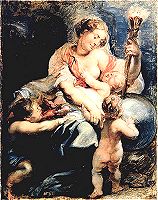 |
Charity Enlightening the World Peter Paul Rubens. Ca. 1627-28 Oil on panel, 36.8 x 29.4 cm Mead Art Museum, Amherst College. Wearing a red bodice that exposes one breast and a gray skirt, Charity is seated with three small children. One lies in her lap, another in blue drapery clings to her thigh, while the third is led by Charity's guiding hand toward a sphere that she illuminates with a torch. This painting is a modello for one of the tapestries constituting the Triumph of the Eucharist series that Rubens executed in about 1627-28 designed for and preserved in the Convent of the Descalzas Reales in Madrid. It is one of three studies for smaller tapestries, all of which have the same egg-and-dart frame, dealing with allegorical subjects. |
The present work undoubtedly has a strong theological message. Since the thirteenth and fourteenth centuries, Charity had been depicted as a maternal figure with children, often three in number, and sometimes in conjunction with a flame (ignis caritatis, the fire of love). Charity also came to be associated with both love of God and love of man. De Poorter suggested that the key to the interpretation of the image is in the large sphere toward which the nude child walks.
The woman holding the torch embodies History or Faith, while the sphere is clearly a terrestrial globe. Thus in the present context Charity may be seen as illuminating and possibly warming the world with the dual aspects of her love for both God and man. 17